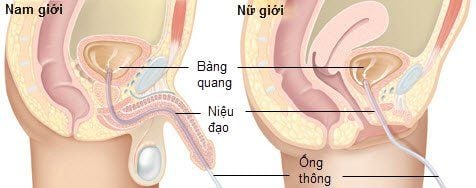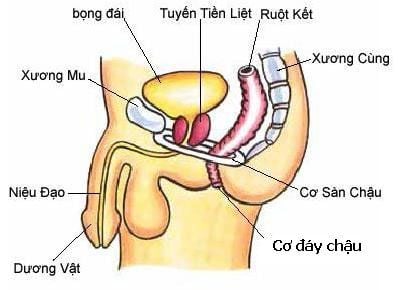This is an automatically translated article.
The article is expertly consulted by Master, Doctor Le Phuc Lien - Urologist - Department of General Surgery - Vinmec Nha Trang International General Hospital. The doctor has more than 12 years of experience in the field of urology and specialized urology.Catheterization in women is the use of a urinary catheter inserted into the bladder through the urethra to bring urine out of the body. A urinary catheter can be placed temporarily to resolve acute urinary retention or left for a period of time, when it is called a continuous urinary catheter.
1. Purpose of female urinary catheterization
The female urinary catheterization technique is one of the very common operations in medicine with many purposes:
Solve acute urinary retention that causes excessive bladder distension and discomfort for the patient. Monitor urine output accurately during the day, especially in severe patients such as shock, severe burns, ... Assess the properties of urine such as color, sediment, blood clots,... Take a water sample urinating during the day, limiting contamination during testing. Empty the bladder before surgery.
2. When is a female catheterization needed?
Although it is simple and has many benefits, it is not allowed to arbitrarily insert a female urinary catheter. The performance of this operation should follow reasonable indications including:
Patients with acute urinary retention and still unable to urinate after taking measures to stimulate urination such as hot compresses and massages. Before performing different types of surgery. Tests with sterile urine samples should be performed to help diagnose urinary tract diseases. Injectable drugs into the urethra, bladder and kidneys are required for imaging or treatment of urinary tract disease. In addition, it should be noted that female urinary catheterization is contraindicated when urethral trauma is suspected, do not attempt deep insertion. This is a general contraindication for catheterization in male patients. However, urethral trauma in women is not as common as in men.
3. Urinary catheterization procedure for girls
In general, the catheterization procedure is not too complicated, but for the safety of the patient, the operator should pay attention to complete each step well.
Hình ảnh mô tả kỹ thuật thông tiểu
View medical records and check that the doctor's orders are correct with the patient's name. Choose a urinary catheter of the right size and material. Briefly explain to the patient the steps to be taken. Announce some information about discomfort and possible complications. 3.2 Prepare equipment The kit for catheterization procedures in women includes:
Hat, mask, clean gloves. Hole, cotton, gauze, nylon sheet, duct tape. Bean tray. Kelly, dissection. The catheter of choice, the most commonly used is a foley or nelaton catheter. In the case of continuous urinary catheterization or retention of the urinary catheter for a period of time, a foley catheter is often chosen. Sterile urine bag, test tube for urine sample. Lights. Vaseline lubricant and antiseptic solution. 3.3 Steps to perform a urinary catheterization Place the patient in the obstetric position: Lie on your back, legs flexed and extended. The patient should remove clothing to expose the lower body. Stretchy covers the thighs and legs. Line a plastic sheet under the patient's buttocks, keep the vulva and anal areas dry. Medical staff should wash their hands according to the principle of surgical hand washing, then wear sterile gloves. The patient's vulva should be washed with physiological saline and antiseptic solution. Lubricate the catheter tip with vaseline. Locate the external urethral orifice and insert the catheter slowly. The urethra in women is shorter than in men, only about 4-6 cm long. The end of the catheter is placed in the pea tray until urine comes out, helping to resolve the acute obstruction. In the case of continuous urinary catheterization, the end of the catheter will be attached to a transparent urine bag with divided lines to help easily monitor the amount and nature of urine daily. Catheterization is a simple operation that the patient can do at home with careful instruction. It is important to emphasize to the patient that they must strictly adhere to the principle of aseptic, wash their hands before and after the procedure.
4. How to monitor a patient with a urinary catheter?

Hình ảnh bác sĩ hỏi thăm bệnh nhân
Quantity: The average urine volume of girls is about 200 - 450 ml. The volume of urine excreted depends and varies with many factors such as the amount of water ingested and the amount of fluid excreted by other routes. Color: Usually the urine is light yellow, sometimes the urine is darker like yellow-brown. Bloody urine will be red, and blood clots may be visible. Sediment: Urine in healthy people is clear yellow, without sediment. In cases of urinary tract infections, the urine often becomes cloudy, and if left for a long time, sediment will appear. Odor: Food and medications can change the smell of urine. An infection or concentrated urine also makes the urine smell worse. Vinmec International General Hospital is one of the hospitals that not only ensures professional quality with a team of leading medical professionals, a system of modern equipment and technology. The hospital provides comprehensive and professional medical examination, consultation and treatment services, with a civilized, polite, safe and sterile medical examination and treatment space.
Please dial HOTLINE for more information or register for an appointment HERE. Download MyVinmec app to make appointments faster and to manage your bookings easily.













